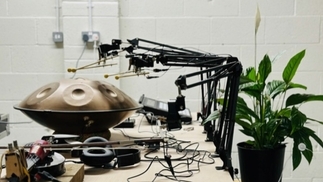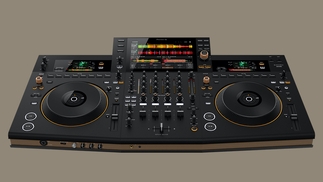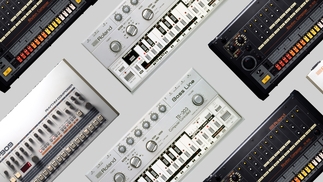RBMA NEW YORK: LASTING LEGACY
Red Bull Music Accademy

DJ Mag was fortunate to sit in on this year's Red Bull Music Academy (RBMA) over in New York where we got to mix it up in their state-of-the-art studio and share some quality time with some of the participants, lecturers and fellow music-lovers who happened to drop in over the month-long extravaganza.
When it comes to educational music events, RBMA has grown from humble beginnings to gargantuan proportions, plucking relatively unknown DJs, producers and artists from obscurity and potentially propelling them deep into the holy grail of the music industry. I mean, spending a day with Hawtin, Moroder or an evening with Questlove — as he firstly talks about his career, then having time to chat to the man up close and personal before getting to enjoy his craft later on at the evening’s event — can't be bad.
This is the stuff of dreams for any aspiring muso, but this is only one element of what RBMA provides. Veiled beyond the cool exterior is a learning facility putting the technology of the studio close at hand for the guys and girls to get deep, down and dirty in the recording and production process.

The studios of the RBMA facility are a smorgasbord of not only the latest technology but also a retro fetishists dream, housing some of the most amazing vintage analogue gear to be made. Some of it even comes from the collection of RBMA founder and synth enthusiast Torsten, who tells the story of how as a kid the love of synthesisers led him on the path to do what he does now.
The studio complex is made up of eight satellite studios, where the participants got to sketch out ideas, as well as a fully specced main studio. The satellite studios were nicely equipped, offering the guys the opportunity to mess around on a variety of gear including Arturia’s excellent MiniBrute, Moog Phatty, Native’s Maschine, Teenage Engineering’s OP1 and a load of Novation gear as well as Genelec 8030 monitors.
These smaller bedroom-sized spaces where constantly in use, allowing for collaborative ideas to take fruit. The satellite studios represented what most dance music producers are familiar with — the type of set-up that many put together in their own bedrooms or spare rooms.
The main studio is a delightfully inspiring space, custom-built by legendary NYC studio designer Frank Comentale. It boasts an 80-channel SSL J-series mixing desk, a George Augspurger monitoring system, and a whole heap of ‘to die for’ outboard gear. The kit-list is amazing with Neve, Manley, Neumann, Fender, Waves, Native Instruments and Arturia making up some of the brand names freely available for the participants to use.

Needless to say, the sound in this space is amazing. Sitting down and messing around in the studio is a joy; cranking up the main monitors delivers a sound that not many get to experience these days, especially when you consider that a lot of dance music producers will never get to record a tune on this type of big main monitor sound as their work is usually done on laptops and headphones — and at best modest, small near-field speakers. The days of going into world class studios is a domain that is usually only graced for the über-stars of the scene.
But this is where RBMA excel because as part of their legacy they leave behind these studio spaces in the cities that they visit for local, up and coming artists to be able to experience recording in a space that exudes creative flair.
When DJ Mag speaks to a couple of up and coming DJ/producer types, Alitrec and Rudi Zygadlo, about their experiences, it's obvious that RBMA leaves a lasting legacy not just to those who attended but anyone who gets a chance to be able to produce and record in the studios.
What was it like being able to get ‘hands-on’ in the RBMA studios and with all the kit that was at hand?
Alitrec: “The studios were really well kitted-out and some of the best gear was brought in by the studio team. Patrick Pulsinger brought in his modular synths and some of the more portable classic Roland analogue synths (TB-303, MC-202) and drum machines. RBMA founder Torsten also contributed the most epic Moog Modular, which sat in the main studio and pretty much did its own thing for the whole two weeks. The rest of the studio team was also around. Flying Lotus went through how he puts his live show together, and Four Tet was on hand to help out with any production issues and talked us through his own live set-up, which was one of the highlights of the studio sessions.
“The smaller studios also had a lot of gear, some of the earlier digital synths like the Yamaha DX7, a range of midi controllers and more recent kit like the newer Moog gear and Teenage Engineering's mini OP-1 synth. There was a lot of stuff to work with.”
Rudi: “Astounding facilities. I’m not a technophile, and I don't understand much about hardware, but there was indeed some serious kit and some informed instructors. The studios were accessible 24 hours a day for the entirety of the two-week term.”

How have things progressed for you since Red Bull Music Academy?
Alitrec: “Things have been progressing well. I've got a few more gigs happening, recently played the Red Bull Music Academy stage at Lovebox and have a set at Fabric coming up later this month. I've also been spending more time on the Vanishing Point label, and we're getting ready to put out some new releases and start a regular night in London. In terms of my own music, I'm working on a new record, some of which I started in New York for the live set at Cameo Gallery.”
Rudi: “In terms of productivity, since New York, I have written a bunch of tunes. I think the Academy was stimulating in that respect. To be amongst so many energetic individuals, excited by their craft, was reinvigorating and helped me emerge from a writing dry spell. Some good projects have also materialised, collaborative, and some new sounds.”
What does the RBMA legacy mean to you?
Rudi: “I think Red Bull Music Academy has such credibility now that to be an academy alumnus is a pretty hat-tipping claim. Practically speaking, it’s nice to be able to walk into the studios in London and know some of the people there. They are also helping me with a project at the moment involving a string quartet; something that may not have seen the light of day had I not attended the academy.”
Alitrec: “You get to meet some pretty incredible people, everyone from the artists who come in to do the lectures, the interviewers, studio team, fellow participants, documentary crews, to everyone on the Red Bull team. There's such an interesting mix of people and there's a lot of time to get to know everyone and set up collaborations. The Academy brings together so many interesting artists and musicians from around the world who you can imagine staying in contact with for years. And you can see that previous participants and studio teams are still around and still want to be involved, it's a great environment.

![Screenshot of [untitled] app interface](/sites/default/files/styles/djm_23_323x182_jpg/public/2023-09/untitled-app-music-new-1400x700.jpg?itok=pro0ZaB4)



